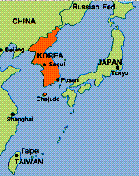 National Flag
National Flag  Land
Land
The Korean Peninsula extends southward from the
eastern end of the Asian continent. Korea is roughly
1,000 km (600 miles) long and 216 km (135 miles) wide at
its narrowest point.
Mountains cover 70% of Korea's land area, making the peninsula one of the most mountainous regions in the world. The lifting and folding of Korea's granite and limestone base has created breathtaking landscapes of scenic hills and mountains. The mountain range that traverses the entire length of the east coast plunges steeply into the East Sea. Aling the southern and western coast, the mountains descend gradually to the coastal plains. These coastal plains produce the bulk of Korea's agricultural crops, specifically rice.
The Korean Peninsula is divided just slightly north of the 38th parallel. The democratic Republic of Korea in the south and Communist North Korea are separated by a Demilitarized Zone
Korea's 99,200 sq.km(24,800acres) is populated by over
70 million people. Administratively, the Republic of Korea
consists of nine provinces (do) ; one special city, Seoul ;
and the five metropolitan cities of Pusan, Taegu, Inch'on,
Kwangju, and Taejon. In total, there are 68 cities (shi)
and 103 counties (gun) in the nine provinces.
In late March or early April, the trees burst into leafy
splendour to mark the beginning of spring. Occasional
showers can be expected from March to May.
During the relatively hot and rainy summer season, the
vegetation is green and lush. The monsoon rains usually
begin at the end of June, however the heaviest rainfall
occurs in July.
The coming of autumn in late September brings
continental winds and clear, dry weather, making the fall
months the most pleasant time of year. The vivid golds and
vibrant reds of the changing leaves create a colorful
panorama.
December to February are cold and dry with occasional
rain or snow. During the winter months, the cold is
normally punctuated by a few warmer days.
CLIMATE

Korea lies in the temperate zone and has four distinct
seasons.
People & Population
The Koreans are one ethnic family speaking one language. Linguistic and anthropological studies as well as legendary sources clearly distinguish Koreans from the Chinese and the Japanese. Sharing distinct physical characteristics, they are believed to be descendants of several Mongol tribes which migrated onto the Korean Peninsula from Central Asia.
Koreans were a homogeneous people by the beginning of the Christian era. In the seventh century A.D. they were politically unified for the first time by the Shilla Kingdom (57 B.C. - A.D. 935) and subsequently witnessed a great cultural flowering.
The Korean people struggled successfully for millennia to maintain their cultural and political identity despite the influence of neighbouring China and the more recent aggressive inclinations of the Japanese. They are a proud people with one of the longest national histories in the world.
The Republic of Korea had a population of 44.5 million in 1994 and registered a density of 447 persons per square kilometer. The population of North Korea was 23.5 million in 1994.
Fast population growth was once a serious social problem in the Republic, as in most other developing nations. Owing to successful family planning campaigns and changing attitudes, however, population growth has been curbed remarkably in recent years. The annual growth rate was 0.90 percent in 1994.
A notable trend in the population structure is that it is getting increasingly older. The 1994 statistics showed that 42.8 percent of productive age, 15 and above, rose from 24,751,000 in 1980 to 33,872,000 in 1994.
Another distinct but unwelcome phenomenon is the continuing migration of rural residents to cities, resulting in heavy population concentrations. Currently, one out of every four Koreans lives in Seoul. Specialists predict that the urban population will increase to 80.6 percent in 2000, up from 74.7 percent in 1990. To cope with the growing urban problems caused by such an imbalance, the government has prepared a long-term manpower development plan. The plan aims at dispersing population to provincial areas through the relocation of economic activities and balanced land development.
Minority groups are almost nonexistent in Korea, apart from some 30,000 Chinese who
are mostly long-term residents in the capital area.
History
After the Korean War, South Korea formed a democratic government and
has made remarkable progress in the area of politics, economics, and
culture with its tireless post-war reconstruction efforts. This culminated in
1993 with the democratic election of the first civilian government, led by
President Kim Youngsam, who has vowed to consolidate the progress made
over the past forty years and establish a solid base for growth into the next
century. South Korea's success has led many underdeveloped
countries to regard it as a model for economic development.
Return to Table of Contents